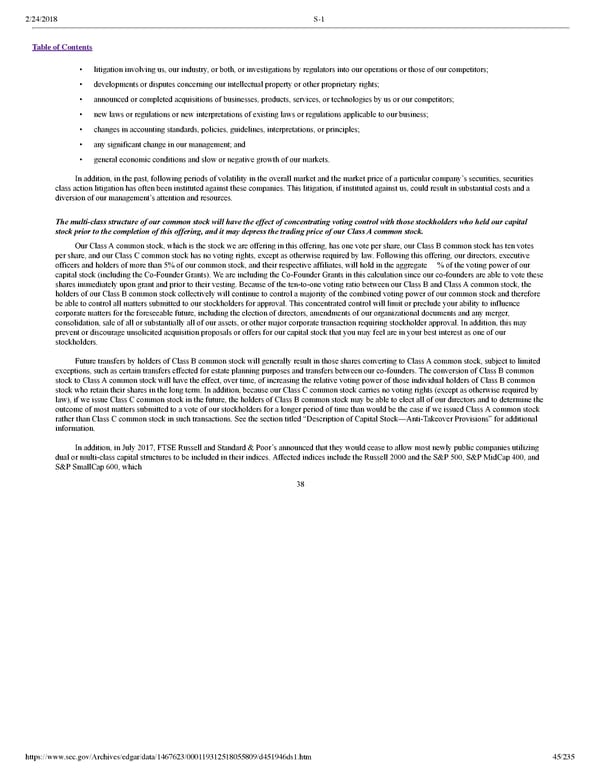2/24/2018 S-1 Table of Contents • litigation involving us, our industry, or both, or investigations by regulators into our operations or those of our competitors; • developments or disputes concerning our intellectual property or other proprietary rights; • announced or completed acquisitions of businesses, products, services, or technologies by us or our competitors; • new laws or regulations or new interpretations of existing laws or regulations applicable to our business; • changes in accounting standards, policies, guidelines, interpretations, or principles; • any significant change in our management; and • general economic conditions and slow or negative growth of our markets. In addition, in the past, following periods of volatility in the overall market and the market price of a particular company’s securities, securities class action litigation has often been instituted against these companies. This litigation, if instituted against us, could result in substantial costs and a diversion of our management’s attention and resources. The multiclass structure of our common stock will have the effect of concentrating voting control with those stockholders who held our capital stock prior to the completion of this offering, and it may depress the trading price of our Class A common stock. Our Class A common stock, which is the stock we are offering in this offering, has one vote per share, our Class B common stock has ten votes per share, and our Class C common stock has no voting rights, except as otherwise required by law. Following this offering, our directors, executive officers and holders of more than 5% of our common stock, and their respective affiliates, will hold in the aggregate % of the voting power of our capital stock (including the CoFounder Grants). We are including the CoFounder Grants in this calculation since our cofounders are able to vote these shares immediately upon grant and prior to their vesting. Because of the tentoone voting ratio between our Class B and Class A common stock, the holders of our Class B common stock collectively will continue to control a majority of the combined voting power of our common stock and therefore be able to control all matters submitted to our stockholders for approval. This concentrated control will limit or preclude your ability to influence corporate matters for the foreseeable future, including the election of directors, amendments of our organizational documents and any merger, consolidation, sale of all or substantially all of our assets, or other major corporate transaction requiring stockholder approval. In addition, this may prevent or discourage unsolicited acquisition proposals or offers for our capital stock that you may feel are in your best interest as one of our stockholders. Future transfers by holders of Class B common stock will generally result in those shares converting to Class A common stock, subject to limited exceptions, such as certain transfers effected for estate planning purposes and transfers between our cofounders. The conversion of Class B common stock to Class A common stock will have the effect, over time, of increasing the relative voting power of those individual holders of Class B common stock who retain their shares in the long term. In addition, because our Class C common stock carries no voting rights (except as otherwise required by law), if we issue Class C common stock in the future, the holders of Class B common stock may be able to elect all of our directors and to determine the outcome of most matters submitted to a vote of our stockholders for a longer period of time than would be the case if we issued Class A common stock rather than Class C common stock in such transactions. See the section titled “Description of Capital Stock—AntiTakeover Provisions” for additional information. In addition, in July 2017, FTSE Russell and Standard & Poor’s announced that they would cease to allow most newly public companies utilizing dual or multiclass capital structures to be included in their indices. Affected indices include the Russell 2000 and the S&P 500, S&P MidCap 400, and S&P SmallCap 600, which 38 https://www.sec.gov/Archives/edgar/data/1467623/000119312518055809/d451946ds1.htm 45/235
 Dropbox S-1 | Interactive Prospectus Page 44 Page 46
Dropbox S-1 | Interactive Prospectus Page 44 Page 46